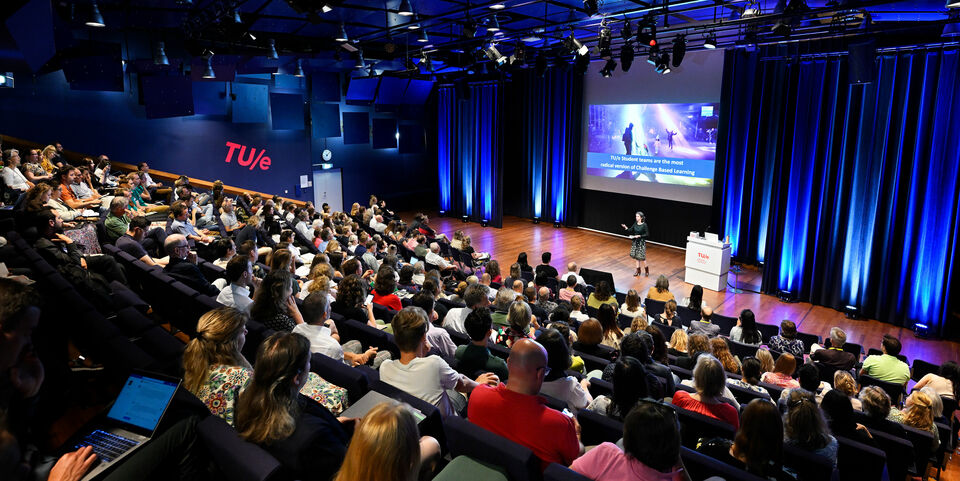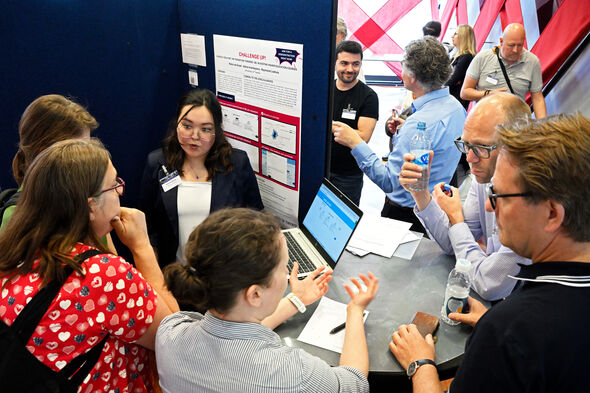Future agents of change prepared with CBL
The opening yesterday morning of the first national conference on challenge-based learning was in the safe hands of Isabelle Reymen, director of TU/e innovation Space, and Ines Lopez Arteaga, dean of the Bachelor College. Their speeches to a full Blauwe Zaal painted a quick picture of the origins of CBL and outlined how this is becoming an established means of delivering the TU/e curriculum. For our teaching staff, the online posting of the CBL toolkit was announced. Cursor also attended one of the many workshops.
That preparations for the conference, attended yesterday by 260 people, had taken their toll was evident when Isabelle Reymen took the microphone. Having almost completely lost her voice at the start of the week, she had avoided talking for the past two days. Speaking just before her, Dean Ines Lopez Arteaga told the audience something of the history to the introduction to Challenge-Based Learning (CBL) and presented its strategic perspective. Where CBL and the Bachelor College 2.0, the recalibrated version due to launch in September, should be heading is, to her mind, clear; these factors will transform the education process: we must move from content delivery to student coaching. Lopez Arteaga: “In the coming years we need to scale up CBL as a means of curriculum delivery while at the same time ensuring that the student continues to acquire deep disciplinary knowledge.” This last issue, she believes, will be the most significant challenge in this change process.
Change agents
Reymen outlined this prospect in broader terms. The idea is that the introduction of CBL, placed within the context of the seventeen Sustainable Development Goals set by the UN, creates the opportunity to prime TU/e students to become agents of change. This, it was said, is something that traditional forms of education - “mass production” in Reymen's words - don't do. “In traditional education the student has no control over what they are given [in terms of curriculum] and this leads to low numbers of motivated students and empty lecture theaters. The student's passion and interest must be given a much greater role [in shaping the curriculum].” According to the innoSpace director, students should learn to deal with uncertainties and must be taken out of their own particular education bubble, in which they find themselves between the ages of fifteen and twenty-four.
Reymen proudly announced to those present, many of whom were TU/e staff, that TU/e now runs forty CBL courses and that these are being taken by four thousand students. “Added to which, innoSpace is home to all our student teams, and their work too is governed by the principles of CBL. There are now about forty teams, about 650 students in total.”
Cooperation
Keeping up a steady pace in spite of her voice problems, Reymen moved on to what else innoSpace offers with a CBL flavor: its own Bachelor's Final Project (BEP), an interdisciplinary and team endeavor; and the ISP Master's, which involves working on an open-ended assignment with many uncertainties, and during which a lot is asked of students in terms of discovering for themselves what they will research. There's also close cooperation with groups such as the Intelligent Lighting Institute (ILI) and the university's four research institutes, as well as with industry. As the supplier of research subjects and experts, who come and teach one day a week, the latter has a role to play in education because students need to learn entrepreneurship before they graduate.
The grants accompanying educational laurels won in recent years will be spent on continued research on CBL in cooperation with the Eindhoven School of Education (ESoE). With undisguised enthusiasm Reymen announced at the end of her talk that the CBL toolkit for teaching staff had been posted online. Registration has opened, so the website says, for demonstration lunches on June 29 and on July 6 and 13, an opportunity to learn how a department can get the most out of using the toolkit. Running out of time, Reymen had to leave the University of the Future, a topic she had wanted to address, for another day.
Read on below the photo.
Asking questions
In the afternoon Cursor joined the workshop ‘Supporting students’ self-directedness in CBL using Coaching for Learning’, given by Jolien Strous, a Teacher Education Specialist at TU/e. It proved a very practical workshop, aimed at instilling in teaching staff the need to hold off supplying their own solutions to the problems or questions raised by students. It emphasized the need to listen closely and to discover the true nature of the problem.
Participants practiced in groups of four comprising two student roles, a teacher and an observer, who would later give feedback on what had taken place in the conversation. The first phase in this kind of conversation is to ask open questions in order to establish how things stand at the present moment. In other words, to try and find out why something has hit a brick wall. Next comes the coaching element, in which the student should be guided towards finding a solution of their own. This involves asking questions that point him or her in the right direction: “Do you know someone who could help you solve this problem?” or “What's the main aim of this plan?” Afterwards, feedback and hints are given. Although, says Strous, where possible 'the hints' should be avoided because it's up to the student to discover the right problem-solving strategy or the right way to handle a situation such as getting other group members to share his or her level of motivation.
Experience in the practice groups revealed that good questioning in an effort to discover the true nature of the problem turns all too quickly into giving hints or suggesting possible solutions. Often the observer's feedback got things back on track, prompting interesting discussions. Moments of insight were plentiful both in this workshop and during the rest of the conference.



Discussion